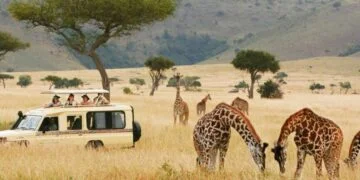Travelers from around the world have long been drawn to Tanzania’s stunning landscapes and rich wildlife. From the iconic plains of the Serengeti to the pristine beaches of Zanzibar, Tanzania offers a diverse array of attractions that have made it one of Africa’s premier tourist destinations. As the country continues to develop its tourism sector, it faces the challenge of balancing economic growth with environmental conservation and cultural preservation.
Overview of Tanzania’s Tourism Sector
Tanzania’s tourism industry is a vital component of the country’s economy:
- Contributing approximately 17% to GDP (pre-pandemic figures)
- Generating over 25% of foreign exchange earnings
- Providing employment for over 1.5 million people directly and indirectly
The sector’s growth has been driven by several factors:
- Diverse natural attractions, including 7 UNESCO World Heritage Sites
- Relatively stable political environment
- Improved infrastructure and air connectivity
- Increasing global interest in eco-tourism and sustainable travel
Key Tourist Attractions
Tanzania boasts an impressive array of attractions that cater to various interests:
- Wildlife Safaris: Home to world-renowned national parks and game reserves, including:
- Serengeti National Park
- Ngorongoro Conservation Area
- Tarangire National Park
- Selous Game Reserve
- Mount Kilimanjaro: Africa’s highest peak and a popular trekking destination
- Zanzibar Archipelago: Known for its pristine beaches, historic Stone Town, and spice tours
- Coastal Attractions: Including Dar es Salaam, Bagamoyo, and marine parks
- Cultural Tourism: Opportunities to engage with Tanzania’s diverse ethnic groups, including the Maasai and Hadzabe
Challenges Facing the Tourism Sector
Despite its potential, Tanzania’s tourism industry faces several challenges:
- Infrastructure Gaps: Inadequate road networks and limited air connectivity to some attractions
- Seasonality: High dependence on peak seasons, leading to fluctuations in employment and revenue
- Competition: Increasing competition from other African destinations like Kenya and South Africa
- Over-tourism: Risk of environmental degradation in popular areas due to high visitor numbers
- Human-Wildlife Conflict: Balancing conservation efforts with the needs of local communities
- Skills Gap: Shortage of well-trained hospitality professionals, particularly in rural areas
Government Initiatives and Policy Framework
The Tanzanian government has implemented several initiatives to promote sustainable tourism development:
- Tanzania Tourism Master Plan: A comprehensive strategy for developing the sector through 2025
- Tourism Promotion: Establishment of the Tanzania Tourist Board to market the country globally
- Infrastructure Development: Ongoing projects to improve roads, airports, and other key infrastructure
- Community-Based Tourism: Encouragement of local participation in tourism activities
- Conservation Efforts: Strengthening of anti-poaching measures and habitat protection programs
Sustainable Tourism Practices
Tanzania is increasingly focusing on sustainable tourism practices to preserve its natural and cultural heritage:
- Eco-lodges: Promotion of environmentally friendly accommodations that minimize ecological impact
- Community Conservation: Involving local communities in conservation efforts and benefit-sharing
- Responsible Wildlife Viewing: Implementation of guidelines to minimize disturbance to animals
- Cultural Preservation: Efforts to maintain authenticity in cultural tourism experiences
- Plastic Waste Reduction: Initiatives to reduce single-use plastics in tourist areas
Innovation in Tanzania’s Tourism Sector
The industry is embracing innovation to enhance visitor experiences and operational efficiency:
- Digital Marketing: Leveraging social media and online platforms to reach global audiences
- Virtual Tourism: Development of virtual reality experiences to complement physical visits
- Mobile Apps: Creation of apps for wildlife tracking, navigation, and local information
- Blockchain Technology: Exploration of blockchain for secure and transparent transactions
- Drone Technology: Use of drones for anti-poaching efforts and wildlife monitoring
Case Study: Singita Grumeti Reserve
The Singita Grumeti Reserve, located adjacent to Serengeti National Park, exemplifies successful integration of luxury tourism, conservation, and community development. Key aspects of their approach include:
- Low-impact, high-value tourism model
- Extensive anti-poaching efforts leading to significant wildlife population increases
- Community outreach programs focusing on education and economic empowerment
- Cutting-edge sustainability initiatives, including solar power and water conservation
This model demonstrates how high-end tourism can contribute positively to both conservation and local communities.
The Impact of COVID-19 and Recovery Strategies
The global pandemic severely impacted Tanzania’s tourism sector, with international arrivals dropping by over 70% in 2020. Recovery strategies include:
- Focus on Domestic Tourism: Encouraging local travel through targeted marketing and incentives
- Health and Safety Protocols: Implementation of comprehensive safety measures to reassure travelers
- Diversification: Development of new products and experiences to attract diverse visitor segments
- Digital Transformation: Accelerating adoption of digital technologies in marketing and operations
- Regional Collaboration: Partnering with neighboring countries for multi-destination packages
Future Outlook and Opportunities
As Tanzania’s tourism sector recovers and evolves, several opportunities and trends are emerging:
- Experiential Travel: Growing demand for immersive, authentic experiences beyond traditional safaris
- Eco-luxury: Increasing interest in high-end, environmentally responsible accommodations
- Adventure Tourism: Potential for growth in activities like mountain biking, rock climbing, and kitesurfing
- Cultural Tourism: Opportunities to showcase Tanzania’s rich cultural heritage beyond wildlife attractions
- Medical Tourism: Potential development of wellness and medical tourism facilities
- MICE Tourism: Expansion of facilities and services for meetings, incentives, conferences, and exhibitions
Conclusion
Tanzania’s tourism sector stands at a crucial juncture. While the industry has been a key driver of economic growth, it must now navigate the challenges of post-pandemic recovery while addressing long-standing issues of sustainability and inclusivity.
The future of tourism in Tanzania will depend on the country’s ability to strike a delicate balance between development and conservation. By embracing sustainable practices, leveraging technology, and fostering community involvement, Tanzania has the potential to become a global leader in responsible tourism.
As the sector evolves, it will be crucial to maintain the authenticity and natural beauty that have long made Tanzania a dream destination for travelers worldwide. With careful planning and innovative approaches, Tanzania’s tourism industry can continue to thrive while preserving the country’s precious natural and cultural heritage for future generations.























